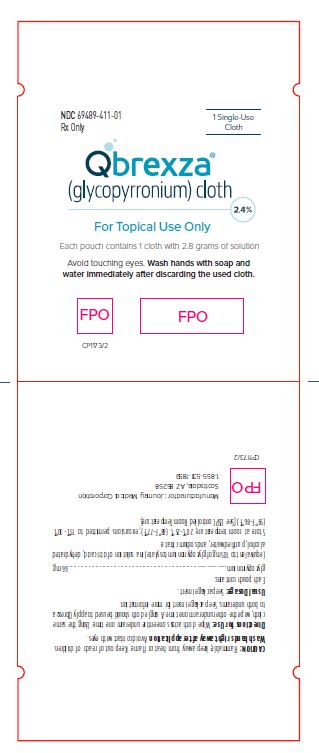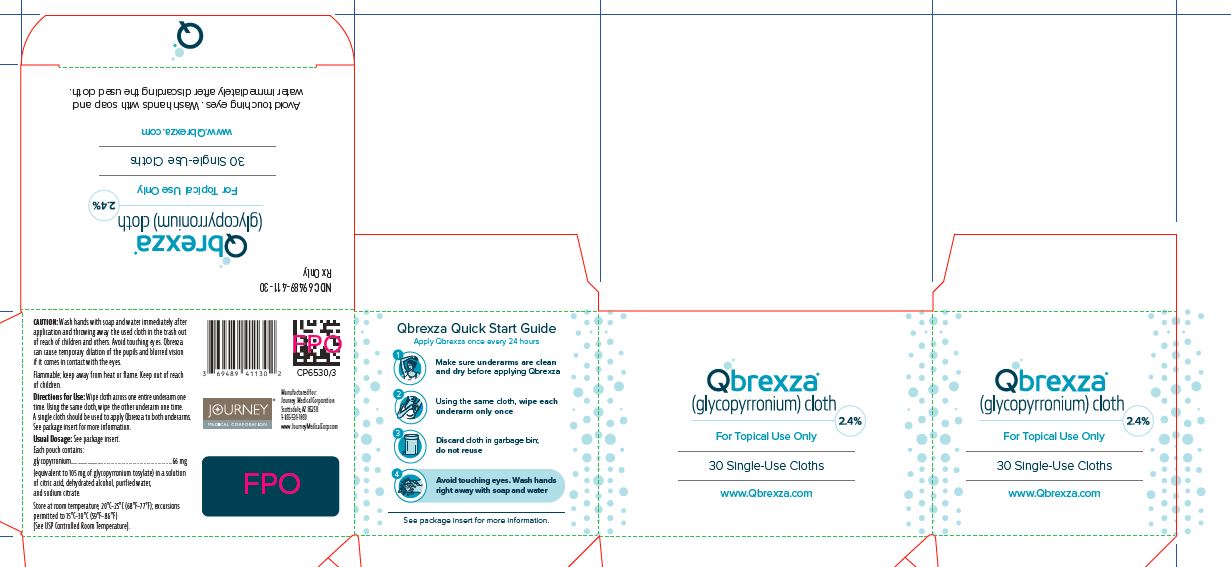Qbrexza
Generic name: glycopyrronium
Dosage form: cloth
Drug class: Miscellaneous topical agents
Medically reviewed by A Ras MD.
What is Qbrexza?
Qbrexza is a prescription anticholinergic medicine used on the skin (topical) to treat excessive underarm sweating (primary axillary hyperhidrosis) in adults and children 9 years of age and older.
It is not known if Qbrexza is safe and effective in children under 9 years of age.
Description
Qbrexza (glycopyrronium) cloth, 2.4% is an anticholinergic drug available as a clear, colorless to pale yellow solution on a single-use pre-moistened cloth (an absorbent polypropylene pad) packaged in a pouch for topical administration. Each pouch contains 105 mg glycopyrronium tosylate, equivalent to 66 mg of glycopyrronium. The inactive ingredients are citric acid, dehydrated alcohol, purified water, and sodium citrate.
Glycopyrronium tosylate is chemically described as pyrrolidinium, 3-[(2-cyclopentyl-2-hydroxy-2-phenylacetyl)oxy]-1,1-dimethyl-, 4-methylbenzensulfonate, hydrate (1:1:1) with an empirical formula of C26H37NO7S and a molecular weight of 507.6. The structural formula is represented below:

Mechanism of Action
Glycopyrronium is a competitive inhibitor of acetylcholine receptors that are located on certain peripheral tissues, including sweat glands. In hyperhidrosis, glycopyrronium inhibits the action of acetylcholine on sweat glands, reducing sweating.
What is the most important information I should know about Qbrexza?
Qbrexza is for use on the skin in the underarm area only.
Who should not use Qbrexza?
Do not use Qbrexza if you ;have certain medical conditions that can be made worse by taking an anticholinergic medicine such as glaucoma, severe ulcerative colitis or certain other serious bowel problems associated with severe ulcerative colitis, myasthenia gravis, and Sjogren’s syndrome.
Talk to your healthcare provider if you are not sure if you have a medical condition that can be made worse by taking an anticholinergic medicine.
What should I tell my healthcare provider before using Qbrexza?
Before using Qbrexza, tell your healthcare provider about all of your medical conditions, including if you:
- have prostate or bladder problems, or problems passing urine
- have kidney problems
- are pregnant or plan to become pregnant. It is not known if Qbrexza will harm your unborn baby.
- are breastfeeding or plan to breastfeed. It is not known if Qbrexza passes into your breast milk. Talk to your healthcare provider about the best way to feed your baby during treatment with Qbrexza.
Tell your healthcare provider about all the medicines you take, including prescription medicines, over-the-counter medicines, vitamins, and herbal supplements.
Qbrexza may affect the way other medicines work causing side effects. Especially tell your healthcare provider if you take anticholinergic medicines.
Know the medicines you take. Keep a list of your medicines with you and show it to your healthcare provider and pharmacist when you get a new medicine.
How should I use Qbrexza?
- Use Qbrexza exactly as your healthcare provider tells you to use it.
- Qbrexza comes as a single-use pre-moistened cloth in individual pouches.
- Qbrexza should be applied to the clean, dry, intact skin, of your underarm areas only. Do not apply Qbrexza to broken skin. Do not cover the treated area with a plastic (occlusive) dressing.
- Apply Qbrexza to both underarm areas using 1 cloth 1 time every 24 hours.
Applying Qbrexza:
- Carefully tear open the pouch to avoid tearing the Qbrexza cloth.
- Unfold the Qbrexza cloth and apply Qbrexza by wiping across 1 entire underarm 1 time. Using the same Qbrexza cloth, wipe across the other underarm 1 time.
- Throw away (discard) the used Qbrexza cloth in the trash.
- Wash your hands right away after you apply Qbrexza and have thrown away the cloth. It is important that you wash your hands because the Qbrexza that is still on your hands can cause you to have blurred vision if you touch your eyes.
- Do not reuse the Qbrexza cloth.
What should I avoid while taking Qbrexza?
- Qbrexza may cause you to have blurred vision that is temporary. If you develop blurred vision, call your healthcare provider, stop using Qbrexza and do not drive, operate machinery, or do hazardous work until your vision is clear.
- Qbrexza is flammable. Avoid heat and flame while applying Qbrexza to your skin
What are the possible side effects of Qbrexza?
Qbrexza can cause serious side effects, including:
- New or worsened urinary retention. People who use Qbrexza may develop new or worse urinary retention. Urinary retention can be caused by a blockage in your bladder. Urinary retention can also happen in men who have a larger than normal prostate. Symptoms of urinary retention may include:
- difficulty urinating
- nausea
- urinating frequently
- urination in a weak stream or drips
- full bladder or difficulty emptying your bladder (distended bladder)
If you have these symptoms, stop using Qbrexza and call your healthcare provider right away.
- Problems with control of your body temperature. Qbrexza can cause you to have decreased sweating in areas other than the underarm area which could cause you to become overheated and to develop heat illness. When in hot or very warm temperatures, watch for lack of sweating on your body (generalized) and stop using Qbrexza if you develop lack of sweating on your body.Stop using Qbrexza and call your healthcare provider right away if you develop any of these symptoms of heat illness:
- hot, red skin
- decreased alertness or passing out (unconsciousness)
- fast, weak pulse
- fast, shallow breathing
- increased body temperature (fever)
- Blurred vision. If you develop blurred vision during treatment with Qbrexza, call your healthcare provider, stop using Qbrexza and do not drive, or operate machinery, or do hazardous work until your vision is clear.
The most common side effects of Qbrexza include:- dry mouth
- dilation of the pupils of your eyes (mydriasis)
- sore throat
- skin redness, burning/stinging or itching in underarm area
- headache
- problems with urination
- blurred vision
- nasal dryness
- throat, eye, and skin dryness
- constipation
These are not all of the possible side effects of Qbrexza.
Call your doctor for medical advice about side effects. You may report side effects to FDA at 1-800-FDA-1088
General information about the safe and effective use of Qbrexza
Medicines are sometimes prescribed for purposes other than those listed in a Patient Information leaflet. Do not use Qbrexza for a condition for which it was not prescribed. Do not give Qbrexza to other people, even if they have the same symptoms you have. It may harm them. You can ask your pharmacist or healthcare provider for information about Qbrexza that is written for health professionals.
How should I store Qbrexza?
- Store Qbrexza at room temperature between 68°F and 77°F (20°C and 25°C).
- Qbrexza is flammable. Keep Qbrexza away from heat and flame.
Keep Qbrexza and all medicines out of the reach of children.
What are the ingredients in Qbrexza?
Active Ingredient: glycopyrronium tosylate
Inactive Ingredients: citric acid, dehydrated alcohol, purified water, and sodium citrate
Label
PRINCIPAL DISPLAY PANEL – NDC: 69489-411-01 – 1-COUNT POUCH LABEL
- NDC 69489-411-01
Rx Only - 1 Single-use Cloth
- Qbrexza™
(glycopyrronium) cloth
2.4% - For Topical Use Only
- Each pouch contains 1 cloth with 2.8 grams of solution

PRINCIPAL DISPLAY PANEL – NDC: 69489-411-30 – 30-COUNT CARTON LABEL
- NDC 69489-411-30
- Rx Only
- Qbrexza™
(glycopyrronium) cloth
2.4% - For Topical Use Only
- 30 Single-use Cloths

SRC: NLM .
